Top Applications of sugar cane products in Modern Industry
Wiki Article
Discover All About Sugar Cane: From Production Methods to Product Innovations
Sugar cane is a crop with both historical importance and modern significance. Its farming has evolved from traditional methods to modern techniques that fulfill today's farming demands. This advancement includes innovative processing strategies that change the cane into a range of items. As the sector encounters ecological difficulties, new lasting methods are emerging. The complexities of sugar cane production and its future in worldwide markets existing appealing concerns worth discovering even more.The History of Sugar Cane Growing
Sugar cane is commonly linked with exotic environments, its growing has an abundant background that dates back thousands of years. Stemming in Southeast Asia, the earliest documents of sugar cane's usage go back to around 8000 BCE, where it was chewed for its sweet taste. By the initial centuries, it spread out to India, where it became important to regional cultures. The modern technology to crystallize sugar emerged in India by the fifth century CE, marking a considerable landmark in sugar production.With the development of profession courses, sugar cane discovered its means to the Center East and, ultimately, Europe. The facility of haciendas in the Caribbean throughout the 16th century changed the worldwide sugar market, driven mostly by early american development. As sugar became a desired commodity, its cultivation shaped economies and societies, preparing for contemporary production strategies that evolved with the advancement of agriculture and innovation.Standard Farming Strategies
As sugar cane growing developed with history, conventional farming techniques became foundational methods that shaped its production. These methods, typically given through generations, included using manual devices such as hoes and machetes for planting and harvesting. Farmers generally prepared the dirt by hand, using crop turning and intercropping to maintain dirt fertility and control bugs. Water management was essential, with several traditional farmers counting on all-natural irrigation systems and rain harvesting.Planting was oftentimes to coincide with seasonal rainfalls, guaranteeing suitable development conditions. Commonly, sugar cane was planted in rows, enabling for simpler maintenance and harvesting. Harvesting was done by hand, needing skilled labor to reduce damages to the stalks. On the whole, standard farming methods stressed sustainability and a deep understanding of the local atmosphere, creating a vital part of the cultural heritage bordering sugar cane agriculture. These techniques laid the groundwork for future improvements in sugar manufacturing.Modern Agricultural Practices
Modern farming techniques have significantly bundled precision farming techniques to improve sugar cane manufacturing. sugar cane products. These techniques make use of data-driven methods to optimize inputs and enhance returns while decreasing ecological influence. Furthermore, sustainable insect administration methods are being embraced to secure crops without jeopardizing ecological balancePrecision Farming Methods
Precision farming methods represent a transformative strategy to farming, leveraging modern technology to boost efficiency and sustainability in sugar cane manufacturing. By making use of devices such as GPS, remote noticing, and information analytics, farmers can monitor plant wellness, dirt conditions, and water use with extraordinary accuracy. This data-driven method permits targeted treatments, decreasing waste and enhancing source allotment. Drones and satellite images help with real-time assessments, allowing growers to respond swiftly to arising concerns or changes in ecological conditions. Additionally, accuracy farming enhances yield projecting and enhances decision-making processes, ultimately bring about much better crop monitoring. Consequently, sugar cane manufacturers can accomplish greater effectiveness and success while minimizing their environmental impact, adding to the overall innovation of modern farming techniques.
Lasting Insect Management
Reliable administration of insects is necessary for preserving the wellness and productivity of sugar cane plants. Sustainable insect administration techniques concentrate on reducing chemical inputs while making the most of eco-friendly balance. sugar cane products. Integrated Parasite Management (IPM) is a preferred strategy, incorporating biological control, habitat control, and making use of immune sugar cane varieties. Farmers are increasingly utilizing valuable insects and natural killers to suppress pest populations, lowering reliance on artificial chemicals. Tracking insect degrees via traps and scouting permits timely treatments, ensuring that control procedures are used just when necessary. Additionally, plant rotation and intercropping improve biodiversity, additional diminishing pest episodes. By taking on these lasting techniques, sugar cane manufacturers can preserve plant yield while advertising environmental stewardship and reducing the adverse influences connected with standard bug control approachesHandling Sugar Cane: From Area to Factory
The complex journey of sugar cane from field to manufacturing facility includes several vital actions that change this dynamic crop into a raw material for sugar manufacturing. After collecting, sugar cane is swiftly delivered to the handling center to reduce sucrose loss. The initial step at the manufacturing facility is washing the cane to eliminate contaminations, complied with by squashing to draw out the juice. This juice undertakes information, where it is heated and treated with lime to eliminate solid bits and impurities.Once cleared up, the juice is focused with evaporation, leading to syrup. The syrup is after that taken shape by cooling and adding seed crystals, resulting in the formation of sugar crystals. Following crystallization, the sugar undertakes centrifugation to divide it from molasses. Ultimately, the sugar is dried out, packaged, and prepared for circulation. Each action in this procedure is crucial for guaranteeing the top quality and effectiveness of sugar production.Sugar Cane Products and Their Applications

Sugar and Natural Sugars
Although often neglected, sweeteners and natural sugars acquired from sugar cane play an important duty in the food and beverage market. These products, consisting of sucrose, molasses, and raw sugar, offer a variety of tastes and capabilities that enhance various food products. Sucrose, one of the most usual sugar, is widely used for its sweetening residential properties, while molasses adds deepness and intricacy to baked items and sauces. All-natural sugars from sugar cane are preferred for their marginal processing and perceived health benefits contrasted to artificial sugar. Additionally, technologies in sugar cane handling have actually caused options like liquid sugar and concentrated cane juice, satisfying diverse consumer choices. On the whole, sugar cane-derived sweeteners are essential to flavoring, maintaining, and enhancing food experiences.Biofuels and Renewable Resource

Sustainability in energy production has actually increasingly transformed attention to sugar cane as a sensible source for biofuels. This exotic crop, abundant in sucrose, can be exchanged ethanol, a renewable fuel that lowers greenhouse gas emissions contrasted to fossil fuels. The fermentation procedure utilizes molasses, a by-product of sugar production, making the most of source performance. Sugar cane's biomass, including bagasse and leaves, can be transformed right into bioenergy, contributing to a round economy. Numerous technologies in processing strategies improve the yield of biofuels, making sugar cane an appealing choice for power diversity. In addition, the growing need for lasting power sources drives research into enhancing farming techniques and decreasing the carbon footprint of biofuel production, positioning sugar cane as a principal in the renewable energy landscape.
Technologies in Sugar Cane Sustainability
As the international need for sugar rises, developments in sugar cane sustainability have actually become essential to fulfill both ecological and economic difficulties. Modern farming methods are being carried out to lower water usage, boost dirt more tips here health and wellness, and lessen chemical inputs. Methods such as precision agriculture utilize information analytics and modern technology to maximize source use and boost crop returns sustainably.Additionally, the development of genetically customized sugar cane ranges aims to boost resistance to insects and environmental stressors, leading to higher performance with fewer inputs. Waste management practices are also evolving; byproducts from sugar cane handling are being transformed right into bioenergy, reducing dependence on fossil fuels.Furthermore, partnerships between agricultural stakeholders and ecological companies are promoting techniques that promote biodiversity and environment health and wellness. These developments not only help you could check here mitigate the ecological impact of sugar cane manufacturing yet additionally produce an extra resistant and lasting sector for the future.The Future of Sugar Cane in Global Markets
While international sugar intake remains to increase, the future of sugar cane in worldwide markets faces both chances and obstacles. The raising demand for biofuels and lasting products provides a substantial chance for sugar cane manufacturers, as the crop can be used for ethanol manufacturing and various other environment-friendly options. On top of that, advancements in processing methods may boost performance and reduce expenses, making sugar cane more affordable versus other sweeteners.However, obstacles such as climate modification, fluctuating market rates, and changing consumer preferences toward much healthier choices complicate the landscape. Moreover, trade plans and tariffs can influence the worldwide market characteristics, impacting farmers' earnings. As stakeholders navigate these complexities, collaboration among manufacturers, governments, and researchers will certainly be vital in adjusting to the developing market. The future of sugar cane pivots on stabilizing these possibilities and obstacles to safeguard its place in a rapidly altering global economic climate.Regularly Asked Questions
How Does Sugar Cane Effect Citizen Ecosystems and Biodiversity?
The cultivation of sugar cane significantly influences neighborhood communities and biodiversity. Monoculture practices can result in habitat damage, while chemical usage may hurt non-target species, ultimately interfering with environmental balance and decreasing species richness in affected areas.What Are the Health Effects of Consuming Sugar Cane Products?
The health and wellness effects of consuming sugar cane products consist of prospective advantages like power increases and anti-oxidants, however excessive intake might lead to weight gain, dental issues, and enhanced threat of diabetic issues, prompting small amounts in intake.Exist Any Kind Of Alternatives to Sugar Cane for Sugar Production?
Alternatives to sugar cane for sugar manufacturing consist of sugar beet, maple sap, and coconut hand sap. These sources provide similar sweetness and can be grown in numerous environments, supplying diverse options for sugar manufacturing worldwide.Just How Is Sugar Cane Affected by Environment Modification?
Environment change significantly impacts sugar cane, triggering modified rainfall patterns, boosted temperatures, and heightened parasite pressures. These factors can lower returns and influence general quality, triggering the demand for flexible farming methods to guarantee sustainability.What Are the Labor Problems for Sugar Cane Employees Globally?
Labor conditions for sugar cane employees around the world differ considerably, often identified by low salaries, long hours, and insufficient precaution. Numerous face exploitation and extreme working atmospheres, particularly in developing nations reliant on sugar cane manufacturing.Report this wiki page